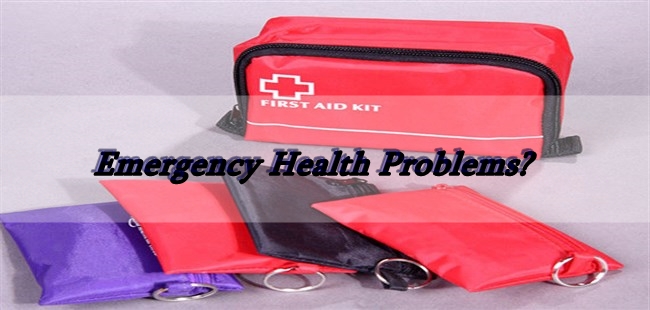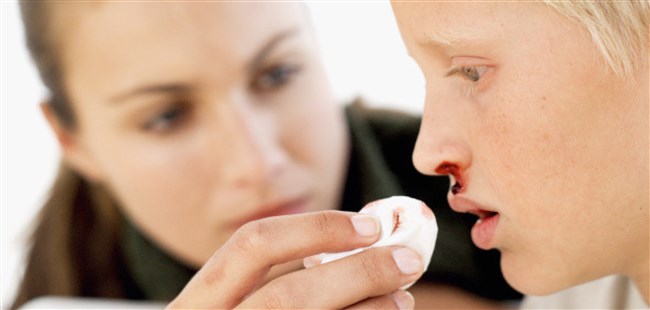Bruising is caused by ruptured blood vessels beneath the surface of the skin, causing blood to leak into surrounding tissue.
Severe bruising may indicate deep injury, such as a fracture. Swelling should be examined carefully, since it also may indicate the severe injury.
Treating Bruises
1. Sit the victim down, with the injured limb supported. Elevate the injured area on a cushion in order to rest it.
2. Apply a cold compress to the injury. Hold the compress against the injury for 30 minutes to reduce the swelling.
Making and Applying a Cold Compress
Making a cold compress: Wring out a clean cloth in cold water, or wrap it around ice cubes. Keep it on the swelling for about 30 minutes, recooling it every five minutes.
Time-saving Tip
Instant compress: If you need a cold compress in a hurry, use a package of frozen peas. Wrap it in a towel and lay over the injury.
The peas should not be eaten, but the package may be used again as an ice pack.
Bone and Muscle Injuries
Treat all bone and muscle injuries as serious until you have discovered the extent of the damage. Look for bruises and swelling, and if you think there may be a fracture, take or send the victim to the hospital for an X-ray. Prevent movements that may aggravate the problem.
Common Bone and Muscle Injuries
• Elevate the injured area, and apply a cold compress. Wrap with cotton and bandage firmly. Take or send the victim to the hospital as soon as possible.
• Dislocated shoulder: This occurs when the head of the arm comes out of the shoulder-joint socket. Support the arm in a sling with the hand across the chest. Get the victim to the hospital as soon as possible. Do not give the victim any food or drink.
• Broken collarbone: Put the arm on the damaged side in a sling. The victim should go to the hospital.
Izing Bone Injuries
Supporting limbs: Bone injuries need to be supported. For an arm, seat the victim and ask her to support her arm across her chest. For a leg, lay the victim down. Support the leg – above and below the injury, not on it – in your hands.
Securing Limbs
Keep the injured part supported by securing it properly. Support an injured arm in a sling, then bandage it to the chest, and take the victim to the hospital. Secure the damaged leg to the uninjured one. Call an ambulance.
Choking
A blocked airway can be frightening for the person who is choking and those around him or her. Action must be quick. Otherwise, the victim may suffocate. Choking is usually caused by eating too fast, or by young children putting small objects in their mouths.
Recognizing & Avoiding Choking
Symptoms: The victim may have difficulty speaking and breathing, and the skin may be blue. The victim may clutch the throat or neck.
Prevention: Encourage family members to chew their food thoroughly. Make sure children do not put foreign objects in their mouths.
Choking In Infants
The treatment for infants differs from the treatment for adults and children. The following steps are a quick outline if your household includes an infant, a first-aid course is recommended.
1. Determine if the airway is completely blocked. The infant’s face may turn blue, and he may make strange noises or no sound at all.
2. Lay the infant face down along your forearm, with the head low. Give five sharp blows to his back.
3. Turn the infant face up. Place two fingers on the breastbone just below the nipple line, and give five sharp downward thrusts. If you can sec an object in his mouth, remove it.
4. For unconscious infants, try to give breaths. Call for help. Repeat back blows and chest thrusts until the airway is cleared or help arrives.
Treating
• If the victim is coughing forcefully, encourage him or her to cough the object up. Call an ambulance.
Choking In Conscious Adults
• If the victim cannot speak, cough forcefully, or breathe, the airway is blocked completely. Stand behind him, and place your arms around his abdomen just above the navel. Center your fist, thumb side in, cover with the other hand, and thrust inward and upward several times (the Heimlich maneuver)
• Continue to administer abdominal thrusts until you dislodge the object. (If this fails and the victim becomes unconscious, follow the treatment below.)
• Once the object has been dislodged, encourage the victim to sit down. Help him calm down.
Treating Choking In Unconscious Adults
• If choking has caused loss of consciousness, call for help as you lay the victim on his back. Give two breaths of rescue breathing. If the chest does not rise, re-tilt head and try the two breaths again.
• If the victim’s chest still does not rise, straddle his body and place the heel of one hand against the middle of the abdomen above the navel. Give up to five abdominal thrusts. Lift tongue and sweep out the mouth if you can see an object.
• Re-tilt the head and give rescue breathing. Continue these steps until breath goes in, breathing resumes, or professional help arrives. Once breathing resumes, place the victim in the recovery position. Get the victim to the hospital.
Forign Bodies
Foreign bodies in the eyes, ears, nose, or throat are unpleasant, can be frightening, and may be dangerous. Use the appropriate technique below to deal with the obstruction, taking care not to cause harm to the victim. Get medical help as soon as possible.
In The Eye
Hold the eyelids apart with two fingers and get the victim to look up, down, left, then right. Carefully pour clean water into the inner corner of the eye to try to wash out the object.
In the Ear
Looking for objects With a flashlight, try to see what is in the ear. If it is embedded, do not remove it – you may damage the eardrum. An adult or older child may know what the object is. Keep the victim calm, and take him or her to the hospital.
Insect In the Ear
• Place the victim in a chair with the affected ear upward. Flood the ear with tepid water so that the insect floats out. Use a towel to catch any overflow.
• If the insect does not come out, or if it is a wasp inside the ear, keep the victim calm, and take him or her to the hospital. Never put anything in the ear to remove a foreign body.
In The Nose
Recognition and treatment An object inside the nose may cause difficulty in breathing, or bloody discharge, or swelling. Encourage the victim to breathe through his mouth, keep him calm, and take him to the hospital. Do not attempt to remove the object even if you can see it.
Swallowed Objects
Identification: Ask the victim what has been swallowed. If it is small and smooth, it will work through the body, but still get medical advice. Large items must be removed by a doctor.
Warning
Do not allow the victim to eat or drink since an anesthetic may be needed. Take the victim to the hospital.
Splinters And Blisters
Splinters and burst blisters may cause infection if they are not treated properly. Remove splinters as soon as possible, but do not try to treat deeply embedded objects. Seat the victim while removing splinters, so that the affected area remains steady.
Removing Splinters
• Wash your hands, then clean the area around the splinter with soap and warm water. Sterilize a pair of tweezers by passing them through a flame. Alternatively, boil them in water for about 10 minutes. Let them cool before you use them.
• Grasp the splinter with the pair of tweezers, as close to the skin as possible. Draw the splinter out at the angle at which it went in. Squeeze the wound so that it bleeds a little to flush out any dirt. Wash the area again, pat dry, and cover with an adhesive bandage
Treating Busters
A blister is, in effect, a sterile dressing protecting an area of damaged skin. Do not puncture it.
Covering blisters: If blister bursts accidentally, apply an adhesive dressing that extends well beyond the blister so that it is not damaged by the adhesive. Burn blisters Burns often cause fluid to collect under the skin. Never disturb it.
Nosebleeds
Nosebleeds often occur unexpectedly, and the victim’s clothes. Frequent and substantial can be frightening if the blood flow is nosebleeds may indicate a serious problem, and copious. Use a towel to clean up and protect the nose should be checked by a doctor.
Treating Nosebleeds
1. Seat the victim with the head tilted forwards. Tell her to breathe through her mouth. Meanwhile, pinch the fleshy part of the nose so that the nostrils stay tightly together for 10 minutes. Lean the victim over a bowl to catch any fluid.
2. Holding the head tilted over a bowl, encourage the victim to spit out excess fluid. Pinch the nostrils for 10 more minutes. Repeat if necessary, but if the bleeding lasts for more than 30 minutes, take her to the hospital
Once the bleeding has stopped, clean around the nose and mouth with a damp towel or cotton wool and tepid water. Instruct her not to blow her nose, since this may cause the nosebleed to start again.
Bleeding Mouth Or Ear
Cuts to the tongue, lips, or lining of the mouth may bleed profusely and cause alarm. A permanent tooth can and should be replanted in its socket – but a child’s milk tooth cannot be replanted. Bleeding from inside an ear usually follows a rupture of the eardrum.
Mouth Wounds
Lean the victim over a bowl to collect the blood. Press the mouth wound with a gauze pad, and pinch it between your thumb and forefinger for about 10 minutes. Do not wash out the victim’s mouth this may disturb a blood clot.
Tooth Loss
As long as the tooth is not a child’s milk tooth, you can replant it in its socket. Alternatively, store the tooth in milk, and place a pad over the socket, making sure it is higher than surrounding teeth so that the victim can bite on it. Take him to a dentist at once.
Ear Injuries
• Ear wounds Place a gauze pad over the wound. Press on the wound for about 10 minutes. When the bleeding stops, cover the wound with a sterile dressing lightly held in place with a bandage. Then take the victim to a doctor.
• Bleeding from inside the ear Seat the victim in a semi-upright position with the head turned towards the injury so that blood drains away. Bandage an absorbent pad over the ear; do not plug the ear. Take the victim to a doctor.
• Danger signs If bleeding from inside an ear follows a head injury, and the blood is watery, fluid may be leaking from around the brain. Take the victim to the hospital.






